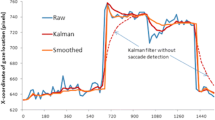Abstract
This study aims to investigate students’ reactions and perceptions to the Learning Analytics Dashboard (LAD). LAD was designed and developed by researchers to present students’ online learning activity in a visualized display. An eye tracking system was incorporated to measure students’ eye-movement, including eye fixation, saccade and their sub derivatives on LAD. The results are derived from the data-mining of what the eye-tracking system generates. This study is expected to support a smart learning environment, where students can effectively monitor their online behavior patterns in real-time using their mobile devices. Students can utilize such information to change their learning patterns, and improve performance.
Access this chapter
Tax calculation will be finalised at checkout
Purchases are for personal use only
Preview
Unable to display preview. Download preview PDF.
Similar content being viewed by others
References
M. Brown, “Learning analytics: the coming third wave,” EDUCAUSE Learning Initiative Brief, pp. 1-4, 2011.
M. Chatti, M. Jarke, T. Indriasari, and M. Specht, “NetLearn: Social Network Analysis and Visualizations for Learning,” in Learning in the Synergy of Multiple Disciplines. vol. 5794, U. Cress, V. Dimitrova, and M. Specht, Eds., ed: Springer Berlin Heidelberg, 2009, pp. 310-324.
N. Bousbia and I. Belamri, “Which Contribution Does EDM Provide to Computer-Based Learning Environments?,” in Educational Data Mining, ed: Springer, 2014, pp. 3-28.
A. Bayazit, P. Askar, and E. Cosgun, “Predicting learner answers correctness through eye movements with random forest,” in Educational data mining: Applications and trends, A. Pena-Ayala, Ed., ed Switzerland: Springer, 2014.
L. Cowen, L. J. Ball, and J. Delin, “An eye movement analysis of web page usability,” in People and Computers XVI-Memorable Yet Invisible, ed: Springer, 2002, pp. 317-335.
W. Huang and P. Eades, “How people read graphs,” in proceedings of the 2005 Asia-Pacific symposium on Information visualisation-Volume 45, 2005, pp. 51-58.
S. Laqua and P. Brna, “The focus-metaphor approach: A novel concept for the design of adaptive and user-centric interfaces,” in Human-Computer Interaction-INTERACT 2005, ed: Springer, 2005, pp. 295-308.
I. Jo, “Beyond learning analytics: Educational technology approach toward learning analytics,” presented at the Asian Conference in Education and Technology 2013, Seoul, Korea, 2013.
I. Jo and J. Kim, “Investigation of Statistically Significant Period for Achievement Prediction Model in e-Learning,” Journal of Educational Technology, vol. 29, pp. 285-306, 2013.
I. Jo and Y. Kim, “Impact of learner’s time management strategies on achievement in an elearning environment: A learning analytics approach,” The Journal of Educational Information and Media, vol. 19, pp. 83-107, 2013.
I. Jo, M. Yoon, and K. Ha, “Analysis of relations between learner’s time management strategy, regularity of learning interval, and learning performance: A learning analytics approach,” presented at the E-learning Korea 2013, Seoul, COEX, 2013.
I. Jo and T. Yu, “Relationship of Student Online Behavior and Learning Performance in Higher Education: A Learning Analytics Approach,” presented at the E-learning Korea 2013, Seoul, COEX, 2013.
Author information
Authors and Affiliations
Corresponding author
Editor information
Editors and Affiliations
Rights and permissions
Copyright information
© 2015 Springer-Verlag Berlin Heidelberg
About this paper
Cite this paper
Ha, K., Jo, IH., Lim, S., Park, Y. (2015). Tracking Students’ Eye-Movements on Visual Dashboard Presenting Their Online Learning Behavior Patterns. In: Chen, G., Kumar, V., Kinshuk, ., Huang, R., Kong, S. (eds) Emerging Issues in Smart Learning. Lecture Notes in Educational Technology. Springer, Berlin, Heidelberg. https://doi.org/10.1007/978-3-662-44188-6_51
Download citation
DOI: https://doi.org/10.1007/978-3-662-44188-6_51
Published:
Publisher Name: Springer, Berlin, Heidelberg
Print ISBN: 978-3-662-44187-9
Online ISBN: 978-3-662-44188-6
eBook Packages: Humanities, Social Sciences and LawSocial Sciences (R0)




